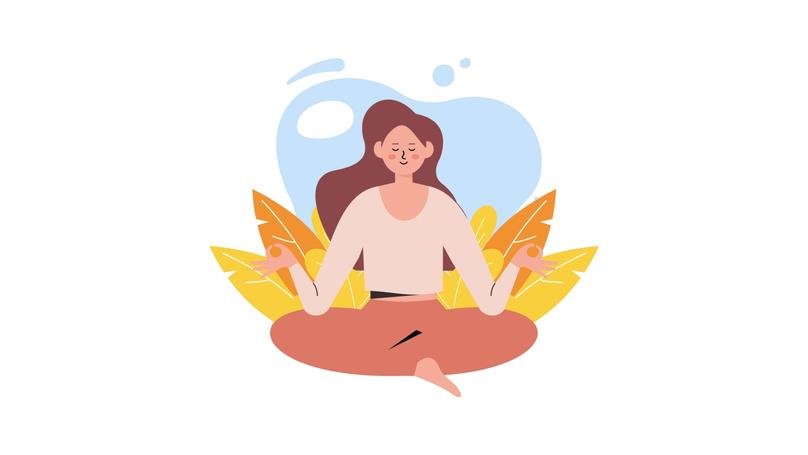Don't lose heart: how to prepare for autumn mentally and physically
Many people seem to dread autumn, believing that this season brings a decline in immunity, productivity, and mood. You feel like hiding under a duvet and not coming out until next spring. However, autumn is a beautiful time of year! All it takes is the right approach and a bit of preparation.

Autumn, a transitional period from warm to cold, can bring about noticeable changes in well-being. Numerous studies indicate that autumn is a time when nervous disorders and chronic diseases tend to worsen. It's crucial to recognize that these issues don't arise independently but are triggered by a mix of external factors, such as temperature fluctuations, a significant decrease in sunny days and light exposure, dietary changes (like moving from fresh vegetables to pickled ones), and more. Therefore, you can prevent changes in your physical and mental well-being by reducing the impact of these factors. And here's how to do it!
How to Prepare Your Body for Autumn

The tips we've gathered fall into two categories: those that will help your body prepare for the new season and those that will help you prepare mentally. Let's begin with the first category.
Change your sleep pattern
Have you noticed that you're always sleepy in the autumn? The season has changed, but you're still following your summer sleep schedule. There's no one-size-fits-all guide to getting enough sleep, as much depends on your needs. However, the fundamental rule is to aim for 7 to 9 hours of sleep to feel well-rested. Typically, during the darker months, this sleep duration tends to be longer due to the extended length of the night (which we'll discuss further below). For this reason, it's beneficial to adjust your schedule slightly by waking up earlier and going to bed earlier to make the most of the daylight.
Be mindful of the changes in your sleep patterns as autumn begins. For instance:
-
You notice it takes longer to "get going" in the morning. To counter this, try waking up 15-20 minutes earlier to lie in bed longer.
-
If you feel sleepy during the day, consider setting aside 30-40 minutes for a nap (if other adjustments to your routine don't help).
-
If you feel sleepier in the evening, adjust your routine and go to bed earlier.
In summary, pay attention to your body's signals and let go of your old "summer" routine, as it becomes less relevant once summer ends. Try adapting to the new weather and seasonal changes rather than resisting them and the natural biological developments.
Ensure you get enough vitamin D
As you know, sunlight is the primary source of vitamin D, and it becomes significantly scarcer with the arrival of autumn. As the nights grow longer and the days shorter, the vitamin D deficiency becomes more pronounced, especially as winter approaches and its production slows down. Interestingly, we tend to feel sleepier during the dark and cold seasons due to melatonin, a hormone produced in the dark that promotes sound sleep. This hormone is most actively produced in autumn and winter. In summary, a state similar to hibernation is promoted after summer ends, akin to bears.
However, there's a solution! Vitamin D is available in various dietary supplements and can also be found in fatty fish (especially salmon), butter, cheeses, liver, and egg yolks. Regular walks outside during daylight hours and using additional light sources at home, especially lamps that mimic natural light, can also be beneficial. Consider getting a few of these lamps, or you can create a cozy atmosphere with lighting: hang garlands, set up beautiful glass night lights, or put up a glowing clock. The brighter it is in your home during autumn, the more energetic you will feel.
Ensure you maintain a healthy diet

Let's discuss "autumn nutrition" separately. In reality, there aren't any special rules for what you should or shouldn't eat during autumn-the guidelines are the same as for any other time of year. A balanced meal should consist of 3 to 5 foods in small portions. Ideally, your meals should combine proteins, grains, dairy products, and fruits and vegetables. This way, you'll provide your body with a variety of nutrients.
Do not divide food into healthy and unhealthy! Allow 15% of your diet to include foods that may not be exceptionally nutritious but are tasty and boost your mood, like chocolate and cookies. This is crucial for physical health (carbs and sugar) and maintaining a positive mood. Also, skip dieting during this season. During autumn and winter, we expend more energy than at any other time of the year, and we primarily replenish this energy through food. At the very least, the body needs extra energy for thermoregulation and to sustain immunity during temperature changes.
Important! If you frequently catch colds during autumn, include vitamin C-rich foods. Rose hips are packed with vitamin C, with 100 grams providing nine times the daily requirement for an adult, making them especially beneficial when you're already under the weather.
Drink less alcohol
Alcohol is a depressant. It temporarily alters brain chemistry, leading to a brief suppression of your nervous system. Initially, these changes bring about a sense of euphoria and a surge in endorphin production. However, this is soon followed by an active increase in cortisol, the stress hormone. Therefore, while alcohol may initially boost your mood, it will eventually bring it down. This doesn't mean you need to avoid alcohol altogether, but be aware that its negative impact on your nervous system can be particularly noticeable in the autumn.
Observe the temperature
Both outside and in your own home. It's crucial to watch the weather forecast in the autumn! This helps you stay warm when needed and prevents pressure surges that often affect people with cardiovascular diseases during this season. Joint pain and headaches are also inevitable companions of autumn for older people. According to a study by the University of Michigan, a sudden drop in temperature outside by 5 degrees can increase the risk of a heart attack by 5%.
Set up humidifiers and heaters in your home to maintain a consistent temperature in the rooms you use most frequently. If you need to go outside, avoid prolonged exposure to the cold. Short walks of 20-25 minutes are sufficient until you adjust to any sudden temperature changes.
How to prepare your home, career, and mood for autumn

The mood you experience during autumn largely depends on how well your body prepares for the season, as our emotions and anxiety are driven by basic biochemistry. However, it's far more effective in simultaneously addressing your physical health and morale. Each will boost the other, ensuring you have a fantastic autumn. Here are some tips to help you prepare yourself, your environment, and even your current career for autumn.
Turn autumn into a special time of year
Any time of year can be special. Take summer, for instance-you enjoy ice cream, go swimming, and soak up the sun, don't you? These are summer traditions that most people enjoy. In winter, it's common to have snowball fights, sip on cocoa, and decorate the Christmas tree, among other activities. And what is customary to do in autumn? Autumn is also full of unique traditions and activities that let you experience the romance of this season and appreciate its colors-perhaps not as bright, but still beautifully muted. Create your list of activities to embrace and enjoy autumn fully. For example, you might:
-
Bake an apple pie (just in time!)
-
Compile a list of classic autumn films, such as "Sweet November," "Practical Magic," "When Harry Met Sally," and "Children of the Corn," among others.
-
Stroll through the park with a pumpkin latte in hand.
-
Buy a new scarf or even a coat.
-
Cozy up under the covers with a good book for the weekend.
-
Celebrate Halloween by watching a spooky movie like "Children of the Corn"-it's perfect for the occasion!
-
Create a healthy autumn menu featuring seasonal dishes like pumpkin soup, turkey, and apple pie.
-
Visit restaurants and cafes to sample their autumn specials, especially the seasonal drinks that cafes love introducing.
Clean out your wardrobe and change your style
Decluttering your home, workspace, or wardrobe can give you freedom and help clear your mind. Early autumn is the perfect time to go through your summer clothes and discard, store, or donate the items you didn't wear over the past three months. Clear your shelves, bring out your autumn clothes, and organize them. You might rediscover a beautiful coat you've forgotten about. Or perhaps you'll realize you're missing something in your wardrobe, like a pair of oxford shoes?
Treat yourself to something autumnal! This is the perfect time to experiment with gothic fashion, which suits the season well, or any other style you fancy. Picture a vintage checkered jacket against crimson and gold leaves, paired with oxford shoes and beige trousers, or a dress with white sleeves and a collar. Refresh your look this autumn by trying something new. It might even be the perfect time for a new haircut.
Create an enjoyment plan

Alongside your list of "autumn rituals" to fully embrace the season, create a list of activities that bring you joy and thoughtfully plan your leisure time. To start, think about your hobbies and activities that help you recharge after a long day at work, and make sure to dedicate more time to them than usual. For example, if you enjoy playing video games, dedicate 1-2 hours daily to them, whether during your commute or at home after dinner, if that helps you unwind. The key is to enjoy your hobbies in moderation and not spend all your free time on them. Instead, plan when and how you'll relax. The main thing is that you enjoy it.
Choose small things that give you joy to brighten your autumn weekdays, like enjoying hot chocolate at lunch, taking walks with your favorite dog before bed, or indulging in a bubble bath in the evening. If autumn makes you feel down, increase these small pleasures and dedicate your days off entirely to them.
Discover an activity you missed out on during the summer
You probably didn't get to do at least one thing over the summer. Maybe it's visiting a neighboring city, going horseback riding, watching a movie at an open-air cinema, or taking a boat ride, for example. You can still enjoy these activities at the beginning of autumn while it's still warm or even later if they don't require being outdoors. Recall the activities you missed during the summer and finally do them to brighten up the challenging autumn period.
Discover techniques to combat anxiety
Anxiety tends to rise in autumn due to the factors mentioned earlier, but it can be managed. Techniques from cognitive behavioral therapy are particularly effective in reducing it. One of the most straightforward techniques, ideal for moments of acute anxiety when you can't shift your thoughts, is as follows.
Step outside, take a deep breath, and head to a quiet spot, whether a small park near your office or a larger one. Once there, look around and try to identify and name the things you see:
-
5 shades of yellow (or red, since it is autumn).
-
5 distinct sounds (car horns, birds chirping, music from a nearby bar, etc.)
-
5 different types of clouds in the sky.
-
5 different smells.
-
5 different materials or the texture of things around you.
Next, pick up one of the items you discovered, like an acorn on the ground. Feel it, perhaps even smell it. How would you describe its texture? What color is it? What colors do you see, and where are they? How hard is the object? Is it heavy or light? What size is it? Describe each of its characteristics, focusing solely on that item.
By performing these actions, your anxiety will lessen, as shifting your focus from thoughts to actions helps reduce stress. In our course "How to Help Yourself: Self-Сoaching to Reduce Anxiety," you can discover even more quick methods and techniques for combating anxiety and emotional burnout.
Lectera’s Online Courses by topic
Evaluate your career needs and opportunities.
Autumn is the perfect time to make that long-awaited breakthrough in your career, adjust its direction slightly, or even consider quitting. With everyone back from vacation, the company is gradually picking up pace after the summer break. New projects are being launched, and plans and results are being discussed. Ensure you're prepared for this and clearly envision what you want from your career this autumn.
Identify your key needs. For instance, if you aim to increase your salary by 30%, what steps are required? Discuss this with your management and develop an action plan to achieve this growth. If your need involves a new field of activity, consider the possibility of transitioning within your current company. If that's not feasible, consider quitting and moving to a new company. Conduct a comprehensive review of your current work based on your summer results: identify any skills you lack, tasks that have been challenging in recent months, and what you need to learn to achieve your desired goal, whether it's a specific position or a salary increase. Get a diary and plan your career for at least September and October, outlining projects, tasks, and training.
While autumn might seem dismal after a sunny summer, with its rain, dropping temperatures, and fading nature, it can be a wonderful season that doesn't have to feel heavy or gloomy. Autumn offers unique opportunities that no other season can. Embrace it as something special, and it will be!
Share this with your friends via:
Latest News

A significant stage in the development of the alternative education system has begun in West Northamptonshire in the UK: the County Council is actively calling on parents, guardians, and trustees to participate in shaping the future of this key area.

Outwoods Primary School in Atherstone, Warwickshire, having experienced deep sadness after the loss of their famous cat, Silla, has found solace in a new pet – a Maine Coon named Aloysius O’Hara.

In modern universities, artificial intelligence, and in particular ChatGPT, is rapidly transforming from a controversial tool into a full-fledged student assistant.

An innovative educational project is gaining momentum in UK primary schools, aiming to change attitudes towards video games.

The Massachusetts Institute of Technology (MIT) presents MIT Learn – a revolutionary online platform that opens a “new front door” to access university knowledge and resources.












 Test. Which New Year Archetype Are You?
Test. Which New Year Archetype Are You?
 Test. How Should You Spend the Winter Holidays?
Test. How Should You Spend the Winter Holidays?
 How the Christmas Tree Became the Symbol of the New Year: From Pagan Groves to Sparkling Ornaments
How the Christmas Tree Became the Symbol of the New Year: From Pagan Groves to Sparkling Ornaments
 Test. What Winter Dessert Are You?
Test. What Winter Dessert Are You?
 Test: What Kind of Ancient Goddess Are You?
Test: What Kind of Ancient Goddess Are You?
 Test: Which Great Woman Would Invite You for Tea?
Test: Which Great Woman Would Invite You for Tea?
